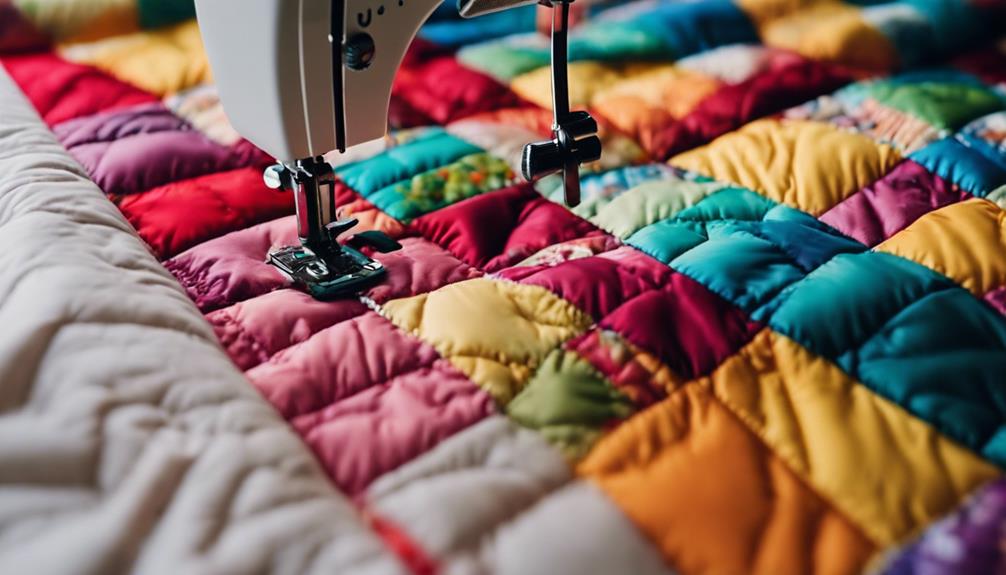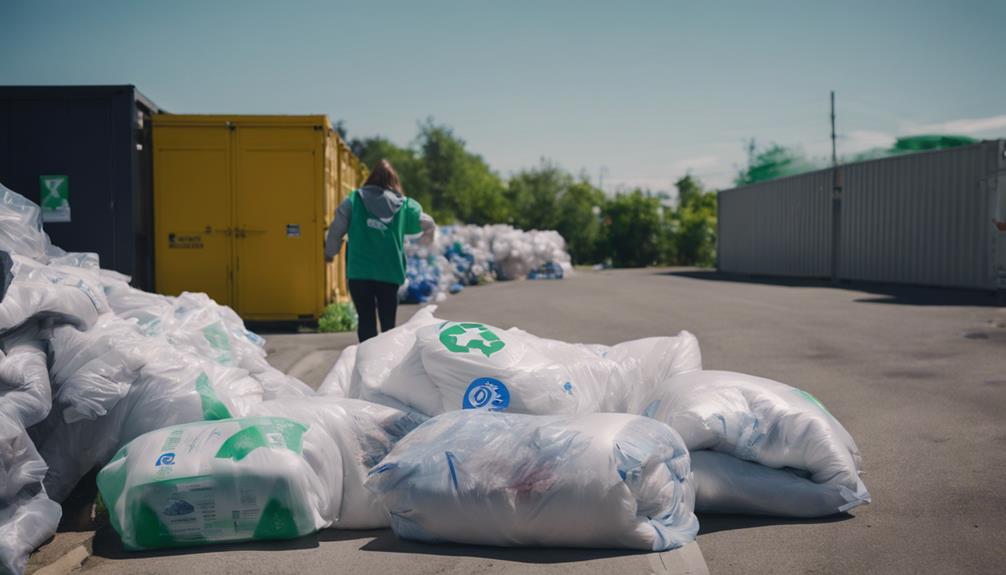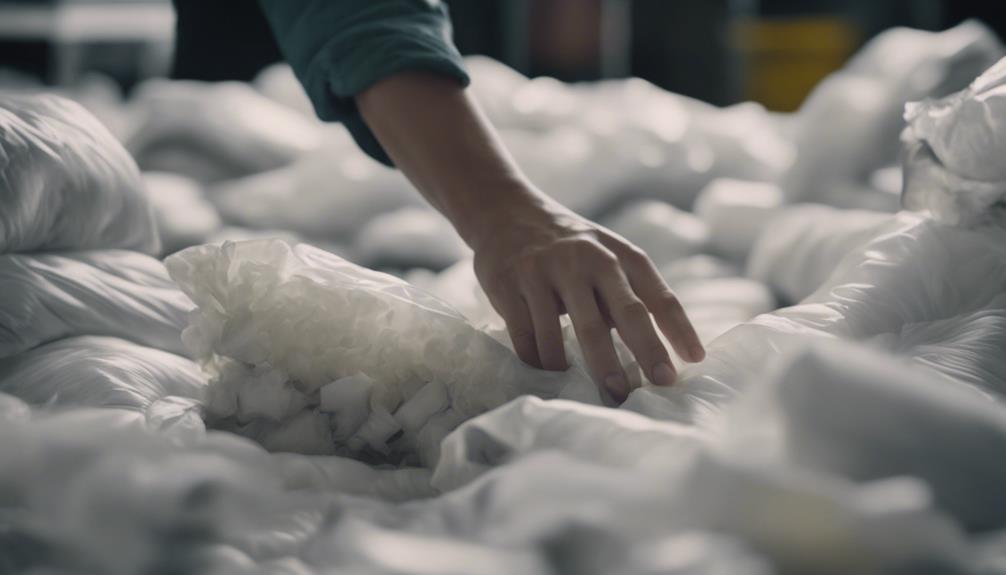When it comes to recycling a down comforter, consider various options available. To start with, local donation centers like GreenDrop and animal shelters, such as the Humane Society, accept old blankets and linens, including down comforters. Additionally, look into the American Textile Recycling Service (ATRS) for convenient drop-off locations and TerraCycle Zero Waste Boxes for at-home disposal. Online donation platforms like GreenDrop and Salvation Army, along with community organizations such as the American Red Cross and Goodwill, also welcome down comforter donations. These avenues offer accessible ways to responsibly recycle down comforters and promote environmental sustainability. Discover more about sustainable practices in comforter recycling.
Key Takeaways
- Donate to local centers like American Red Cross through GreenDrop.
- Utilize American Textile Recycling Service (ATRS) drop-off locations.
- Purchase TerraCycle Zero Waste Box for convenient at-home disposal.
- Explore online platforms like GreenDrop and Salvation Army for recycling.
- Consider community organizations, churches, or shelters for down comforter donations.
Local Donation Centers for Down Comforters
We can easily recycle our down comforters by donating them to local centers like the American Red Cross through the GreenDrop program. When our old down comforters have served their purpose, donating them to organizations like the American Red Cross not only helps in textile recycling but also supports charitable causes.
Additionally, animal shelters, such as the Humane Society, are often in need of old blankets and linens to provide comfort to the animals under their care. By choosing to donate our down comforters to these shelters, we extend a helping hand to both the environment and our furry friends in need. It's a simple yet impactful way to give back to the community and make a positive difference.
American Textile Recycling Service Drop-off Locations

Locating American Textile Recycling Service drop-off locations for recycling down comforters is a simple way to contribute to sustainability efforts.
American Textile Recycling Service (ATRS) has thousands of convenient drop-off bins across the U.S. where you can donate old textiles, including down comforters.
If you're unsure where the nearest drop-off site is located, reaching out to the ATRS hotline can help you locate the most convenient option for recycling your old down comforter.
By donating your down comforter to ATRS, you play a part in textile recycling efforts and support sustainability practices in your community.
These drop-off locations make it easy for individuals to participate in environmental initiatives by properly disposing of old textiles like down comforters.
Consider utilizing the ATRS drop-off bins as a simple yet impactful way to give your old down comforter a new purpose in the recycling process.
TerraCycle Zero Waste Box for Comforter Recycling

To further expand on sustainable options for recycling down comforters, TerraCycle offers Zero Waste Boxes specifically tailored for this purpose. These boxes enable individuals to conveniently recycle their old down comforters at home, contributing to sustainable textile recycling efforts.
Here's why TerraCycle's Zero Waste Box for down comforter recycling stands out:
- Convenience: The Zero Waste Box allows for easy disposal of down comforters without the need to leave home.
- Sustainability: By filling the box with a down comforter, individuals actively participate in promoting environmental sustainability.
- Easy Shipping: Returning the filled box to TerraCycle is hassle-free with the provided prepaid return label.
- Partnership: TerraCycle serves as a sustainable bedding partner, ensuring responsible disposal of down comforters and promoting eco-friendly practices.
Participating in TerraCycle's program not only simplifies the recycling process but also contributes to a greener and more sustainable environment through the proper recycling of down comforters.
Online Donation Platforms for Down Comforters

Utilizing online donation platforms facilitates the convenient recycling of down comforters, offering individuals a simple way to contribute to sustainable practices. GreenDrop and Salvation Army are prominent online platforms that accept down comforters for recycling purposes. GreenDrop collaborates with the American Red Cross to streamline the process of donating down comforters. On the other hand, Salvation Army welcomes various household goods, including down comforters, for either reuse or recycling. These donation centers provide easy drop-off locations or even pick-up services for down comforter donations, making it hassle-free for individuals to participate in recycling efforts. By using online platforms, donors can schedule pick-ups or find nearby drop-off locations to ensure their down comforters are properly recycled. This convenient approach not only helps in reducing waste but also promotes sustainable living practices.
| Online Donation Platforms | Acceptance of Down Comforters | Recycling Options |
|---|---|---|
| GreenDrop | Yes | Partnered with American Red Cross for donations |
| Salvation Army | Yes | Reuse or recycling of household goods, including down comforters |
Community Organizations Accepting Down Comforters

In our community, several organizations enthusiastically accept donations of down comforters to support various causes. These donations not only help those in need but also promote sustainability by giving these items a new life.
Here are some community organizations that welcome down comforter donations:
- American Red Cross: Through the GreenDrop program, the American Red Cross accepts down comforters for donation, aiding their humanitarian efforts.
- Salvation Army: This organization gladly welcomes household items like down comforters, blankets, and pillows, supporting their mission to assist individuals and families in crisis.
- Goodwill: While excluding severely damaged items, Goodwill accepts gently used linens, contributing to their initiatives to empower individuals through employment opportunities.
- Local Churches and Homeless Shelters: These places often appreciate donations of down comforters and other bedding items to help those experiencing homelessness stay warm and comfortable.
Consider reaching out to these organizations in our community to make a meaningful impact through your down comforter donations.
Eco-Friendly Options for Comforter Disposal

Considering the environmental impact of disposing of comforters, exploring recycling options emerges as a sustainable solution.
Old comforters can be recycled at specialized recycling centers that handle textile products. By choosing to recycle old comforters, we contribute to reducing waste and promoting a more sustainable environment.
These recycling centers process the old comforters into new products, minimizing the impact on landfills. This eco-friendly disposal option is a proactive way to guarantee that our old comforters don't end up in a landfill, where they'd take up space and contribute to environmental harm.
Upcycling Ideas for Old Down Comforters

Let's explore creative ways to repurpose old down comforters into practical and eco-friendly items. Old bedding can find new life through upcycling ideas that benefit both you and the environment.
Here are four inventive ways to repurpose your old down comforters:
- Pet Beds: Sewing a cover for a pet bed filled with the soft down from your old comforter can provide a cozy spot for your furry friends to rest.
- Throw Pillows: By cutting and stitching the fabric into smaller squares, you can create stylish throw pillows for your living room or bedroom.
- Floor Cushions: Stuffing large cushions with the down filling can offer extra seating or a comfortable spot to relax on the floor.
- Outdoor Picnic Blankets: Transform your old comforter into a waterproof picnic blanket by adding a durable backing, perfect for outdoor gatherings or camping trips.
Repurposing old down comforters not only reduces waste but also showcases your creativity in finding new uses for old items.
Environmental Benefits of Recycling Down Comforters

Reducing waste and promoting environmental sustainability, recycling down comforters offers significant benefits to our planet. By repurposing these comforters, we contribute to a more sustainable future by minimizing the environmental impact of textile production. Extracting down from old comforters for recycling reduces the need for new resources, aligning with a circular economy approach that emphasizes reusing materials. Upcycling down into organic fertilizer provides a sustainable solution that benefits both the environment and agriculture. The table below highlights the environmental benefits of recycling down comforters:
| Benefits | Description |
|---|---|
| Waste Reduction | Recycling down comforters helps reduce waste in the textile industry. |
| Circular Economy | Repurposing down comforters contributes to a circular economy by reusing materials. |
| Resource Minimization | Extracting down from old comforters minimizes the need for new resources. |
Sustainable Practices in Comforter Recycling

To achieve sustainable practices in comforter recycling, we prioritize the utilization of eco-friendly processes and materials. When it comes to recycling down comforters, there are several key strategies that help us reduce waste and promote environmental responsibility:
- Partnering with recycling facilities: Collaborating with specialized facilities, such as ALLIED FEATHER, allows us to repurpose old comforters efficiently, supporting the circular economy and reducing the need for new resources.
- Eco-friendly processes: Implementing environmentally friendly techniques in the recycling of comforters ensures that we minimize our impact on the planet while giving these materials a new life.
- Material repurposing: By repurposing old comforters into new products, we decrease the demand for fresh materials, contributing to the conservation of resources and energy.
- Environmental conservation: Embracing sustainable practices in comforter recycling plays a significant role in environmental conservation efforts, helping to protect our planet for future generations.
Tips for Responsible Down Comforter Disposal

When it comes to responsibly disposing of down comforters, we've a few key points to ponder.
Options for down comforter disposal range from donating to repurposing.
Environmentally-friendly methods guarantee old comforters find new life in sustainable ways.
Down Comforter Disposal Options
Exploring various avenues for responsibly disposing of old down comforters can make a significant impact on reducing waste and supporting sustainability efforts.
- Donate: Consider giving your old down comforter to organizations like Goodwill or Salvation Army to benefit those in need.
- Repurpose: Extend the lifecycle of your comforter by turning it into items like doormats or mattress pads.
- Drop-off Locations: Utilize designated locations or charity organizations for down comforter donations to promote responsible disposal.
- Textile Recycling: Engage in textile recycling initiatives such as TerraCycle to further contribute to sustainability efforts.
Environmentally-Friendly Disposal Methods
Considering the environmental impact of disposing of old down comforters, we can explore environmentally-friendly methods that promote sustainability in the bedding industry.
To guarantee responsible disposal, look for reputable organizations such as Allied Feather and Down, known for proper recycling processes.
By participating in specialized recycling programs, old down bedding can be transformed into new down bedding products, minimizing waste and supporting a circular economy.
Recycling down comforters not only reduces environmental impact but also encourages responsible consumption and production practices.
Choosing to recycle old down bedding is a proactive step towards promoting sustainability and reducing waste in the bedding industry.
Frequently Asked Questions
How to Get Rid of a Down Comforter?
To get rid of a down comforter, consider donating it to shelters, charities, or repurposing it into new items like mattress pads or pet bedding.
Look for local textile recycling facilities, drop-off locations, or check with manufacturers for take-back programs.
Some specialized companies like Allied Feather and Down offer recycling options.
Responsible disposal is important, so explore various avenues to extend the comforter's usefulness and minimize waste.
How Do You Recycle Goose Down Comforters?
When recycling goose down comforters, it's crucial to confirm the presence of goose down by checking the law label.
To support sustainability and reduce waste in the textile industry, consider sending your comforters to specialized facilities like Allied Feather and Down in Montebello, California.
By participating in down comforter recycling efforts, we contribute to a circular economy and promote eco-friendly practices.
Let's take steps towards a greener future by recycling our down products responsibly.
How to Dispose of a Down Duvet?
When disposing of a down duvet, it's best to recycle it through specialized facilities like ALLIED FEATHER in Montebello, California. By doing so, we can reduce waste and support sustainable practices in the bedding industry.
Checking the law label on the duvet confirms if it's made with down and feather for proper recycling.
Effective communication with recycling facilities like ALLIED FEATHER guarantees the duvets are recycled efficiently.
When to Throw Away a Down Comforter?
When it's time to bid farewell to a down comforter, signs like yellow stains, musty smell, clumped feathers, or less coziness indicate it's time for a change.
Repurposing old comforters into various items like doormats or donating them to shelters can be eco-friendly choices.
Responsible disposal, such as recycling or donating, can minimize environmental impact and benefit others in need.
– Can I Recycle an Old Down Comforter?
Yes, you can repurpose old comforter for reuse. Instead of throwing away an old down comforter, consider using it to make pet beds, throw pillows, or even a DIY weighted blanket. The fill can be reused in various creative ways, reducing waste and giving the comforter a new life.
Conclusion
To sum up, when it comes to recycling your down comforter, there are several options available to make certain that it's properly disposed of in an environmentally-friendly manner. By donating to local centers, utilizing recycling services, or exploring upcycling ideas, you can make a positive impact on the planet.
Remember, every small effort counts towards a greener future for all. So, let's take action and make a difference one comforter at a time.









